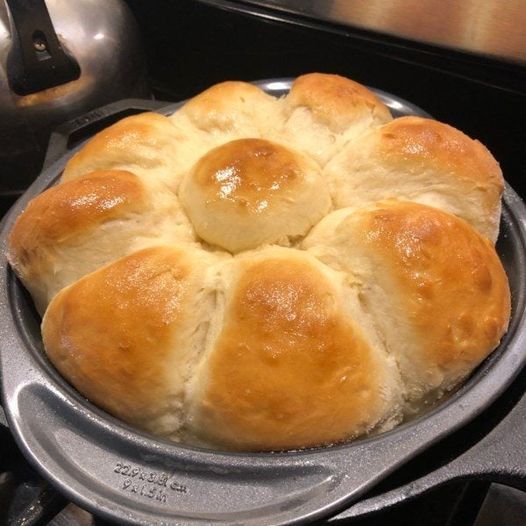These Old Fashioned Yeast Rolls Recipe are rich, fluffy, salty, a little sweet, and absolutely delicious. Between the heavy cream and the honey butter, these dinner rolls are full of moisture. So addicting and worth all of the work, I promise.
Baking homemade bread, like these yeast rolls or my Rosemary Parmesan Bread, has been something I have recently fallen in love with.
If you are new to bread making, start with my Easy Rustic Bread. For something a littler more involved, but absolutely worth the time, try my Cream Cheese Frosting Cinnamon Rolls.
Looking for a quick bread instead? Try this Blackberry Lemon Loaf.
Can you make these rolls ahead of time?
Yes. The day before you want to bake the rolls, complete the recipe through step 7. Cover the baking dish and place the rolls in the refrigerator overnight. Let the rolls rise on the counter for 1-2 hours before baking. Pick back up on step 9.
How do you freeze these rolls?
You can freeze these rolls raw or cooked. To freeze the dough, shape the rolls into balls. Place the balls not touching on a baking sheet lined with parchment paper in the freezer for 3-4 hours. Then you can place them into an airtight bag. Place the frozen rolls into a greased pan and thaw on the counter for 4 hours. Bake according to the recipe. Repeat the same freezing process with cooked rolls so they do not stick together in the freezer. Thaw in the microwave, on the counter, or in the fridge.
Why are my yeast rolls heavy?
Too much flour will create a dense roll. Be sure to measure correctly! Overworking the dough will also create a tough roll.
Why did my yeast rolls not rise?
There are a couple of reasons why the rolls might not be rising. Check to make sure the yeast was not expired. Second, if the milk was too hot, it could kill the yeast. Be sure to use a thermometer. Lastly, too much flour will make the dough too heavy and unable to rise.
INGREDIENTS
1 pkg active dry yeast (equals 2 1/4 tsp)
1/4 c warm water
1/3 c white, granulated sugar
`1/4 c butter, softened
1 tsp salt
1 c hot milk
1 egg, lightly beaten
4 1/2 c sifted all-purpose flour
2 Tbsp butter, melted (for brushing rolls)
DIRECTIONS
- Sprinkle yeast over very warm water in large bowl. Stir until yeast dissolves. Leave to foam about 10 minutes.
- Add sugar, the 1/4 cup butter and salt to hot milk and stir until sugar dissolves and butter is melted. Cool mixture to 105 to 115 degrees.
- Add milk mixture to yeast and then mix in egg. Beat in 4 cups of the flour, 1 cup at a time, to form a soft dough. Use some of remaining 1/2 cup flour to dust a pastry cloth.
- Knead the dough lightly for 5 minutes. Use remaining flour for flouring pastry cloth and your hands.
- Place dough in a warm, buttered bowl; turn greased side up. Cover and let rise in warm place until doubled in bulk, about 1 1/4 to 1 1/2 hours.
- Punch dough down and knead 4 to 5 minutes on a lightly floured pastry cloth. Dough will be sticky, but use as little flour as possible for flouring hands, otherwise rolls will not be as feathery light as they should be.
- With large knife, cut dough ball into four (4) pieces. Cut each piece into four (4) more pieces OR simply pinch off small chunks of dough and roll into round balls about 1 3/4 inches in diameter. As you roll into balls, pull sides down and under to shape roll. Place bottom side down in neat rows, not quite touching, in well-buttered 13 X 9 X 2 inch pan.
- Cover rolls and allow to rise in warm place until doubled in bulk; 30 – 45 minutes. When doubled in bulk, brush tops with melted butter and bake in 375 degree F oven for 18 – 20 minutes or until nicely browned. My oven runs hot so I usually bake @ 325 so tops do not brown before rolls are done inside. Adjust your oven temp accordingly.
- If desired, brush (or bathe!) rolls in more melted butter when they are hot. The butter will sizzle down sides and bottom of rolls for a buttery soft crust.


